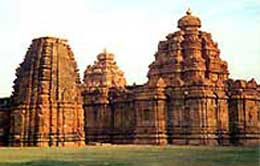The Badami Chalukyas were Brahmanical Hindus but they gave respect to other religions. Importance was given to Vedic rites and rituals. The founder of the dynasty Pulakesin I performed the asvamedha sacrifice. A number of temples in honour of Vishnu, Siva and other gods were also built during this period. Hiuen Tsang mentioned about the decline of Buddhism in western Deccan. But Jainism was steadily on the path of progress in this region. Ravikirti, the court poet of Pulakesin II who composed the Aihole inscription was a Jain.
Art and Architecture
 |
| Ajanta Cave temple |
The Chalukyas were great patrons of art. They developed the vesara style in the building of structural temples. However, the vesara style reached its culmination only under the Rashtrakutas and the Hoysalas. The structural temples of the Chalukyas exist at Aihole, Badami and Pattadakal. Cave temple architecture was also famous under the Chalukyas. Their cave temples are found in Ajanta, Ellora and Nasik. The best specimens of Chalukya paintings can be seen in the Badami cave temple and in the Ajanta caves. The reception given to a Persian embassy by Pulakesin II is depicted in a painting at Ajantha.
The Chalukya temples may be divided into two stages. The first stage is represented by the temples at Aihole and Badami. Among the seventy temples found at Aihole, four are important.
1. Ladh Khan temple is a low, flat-roofed structure consisting of a pillared hall.
2. Durga temple resembles a Buddha Chaitya.
3. Huchimalligudi temple.
4. The Jain temple at Meguti.
 |
| Badami Cave temple |
Among the temples at Badami, the Muktheeswara temple and the Melagutti Sivalaya are notable for their architectural beauty. A group of four rock-cut temples at Badami are arked by high workmanship. The walls and pillared halls are adorned by beautiful images of gods and human beings.
 |
| Pattadakal Virupaksha temple |
The second stage is represented by the temples at Pattadakal. There are ten temples here, four in the northern style and the remaining six in the Dravidian style. The Papanatha temple is the most notable in the northern style. The Sangamesvara temple and the Virupaksha temple are famous for their Dravidian style. The Virupaksha temple is built on the model of the Kailasanatha temple at Kanchipuram. It was built by one of the queens of Vikramaditya II. Sculptors brought from Kanchi were employed in its construction.


